warning AUDI Q5 2014 8R / 1.G Getting To Know
[x] Cancel search | Manufacturer: AUDI, Model Year: 2014, Model line: Q5, Model: AUDI Q5 2014 8R / 1.GPages: 29, PDF Size: 6.93 MB
Page 18 of 29
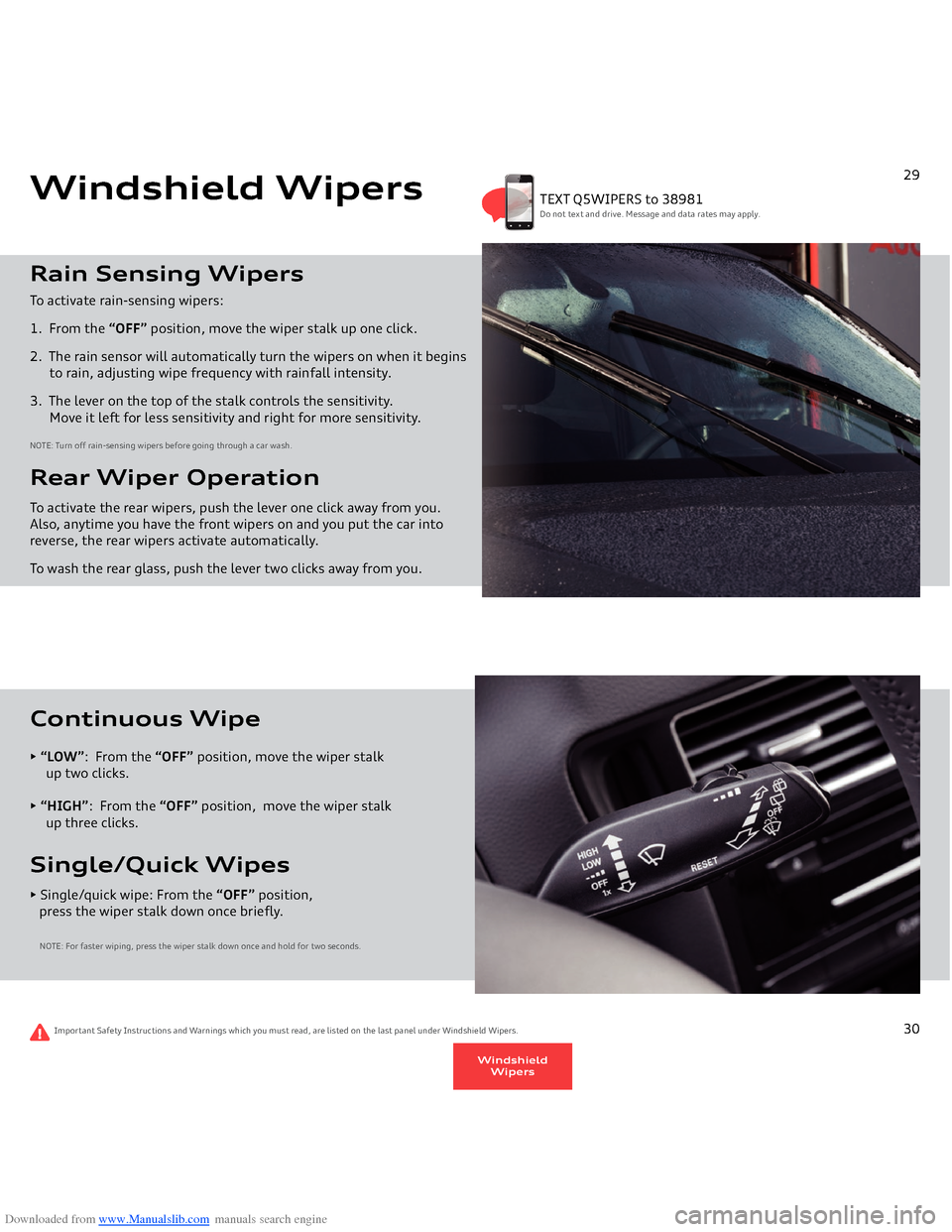
Downloaded from www.Manualslib.com manuals search engine Rain Sensing WipersTo activate rain-sensing wipers:1. From the
“OFF”
position, move the wiper stalk up one click.
2. The rain sensor will automatically turn the wipers on when it begins to rain, adjusting wipe frequency with rainfall intensity.3. The lever on the top of the stalk controls the sensitivity.
Move it left for less sensitivity and right for more sensitivity.NOTE: Turn off rain-sensing wipers before going through a car wash.Rear Wiper OperationTo activate the rear wipers, push the lever one click away from you. Also, anytime you have the front wipers on and you put the car into reverse, the rear wipers activate automatically. To wash the rear glass, push the lever two clicks away from you.Windshield Wipers
TEXT Q5WIPERS to 38981Do not text and drive. Message and data rates may apply.
29
Important Safety Instructions and Warnings which you must read, are listed on the last panel under Windshield Wipers.
• “LOW”
: From the
“OFF”
position, move the wiper stalk
up two clicks.• “HIGH”
: From the
“OFF”
position, move the wiper stalk
up three clicks.Continuous Wipe• Single/quick wipe: From the
“OFF”
position,
press the wiper stalk down once briefly.
NOTE: For faster wiping, press the wiper stalk down once and hold for two seconds.Single/Quick Wipes
30
WindshieldWipers
Page 19 of 29
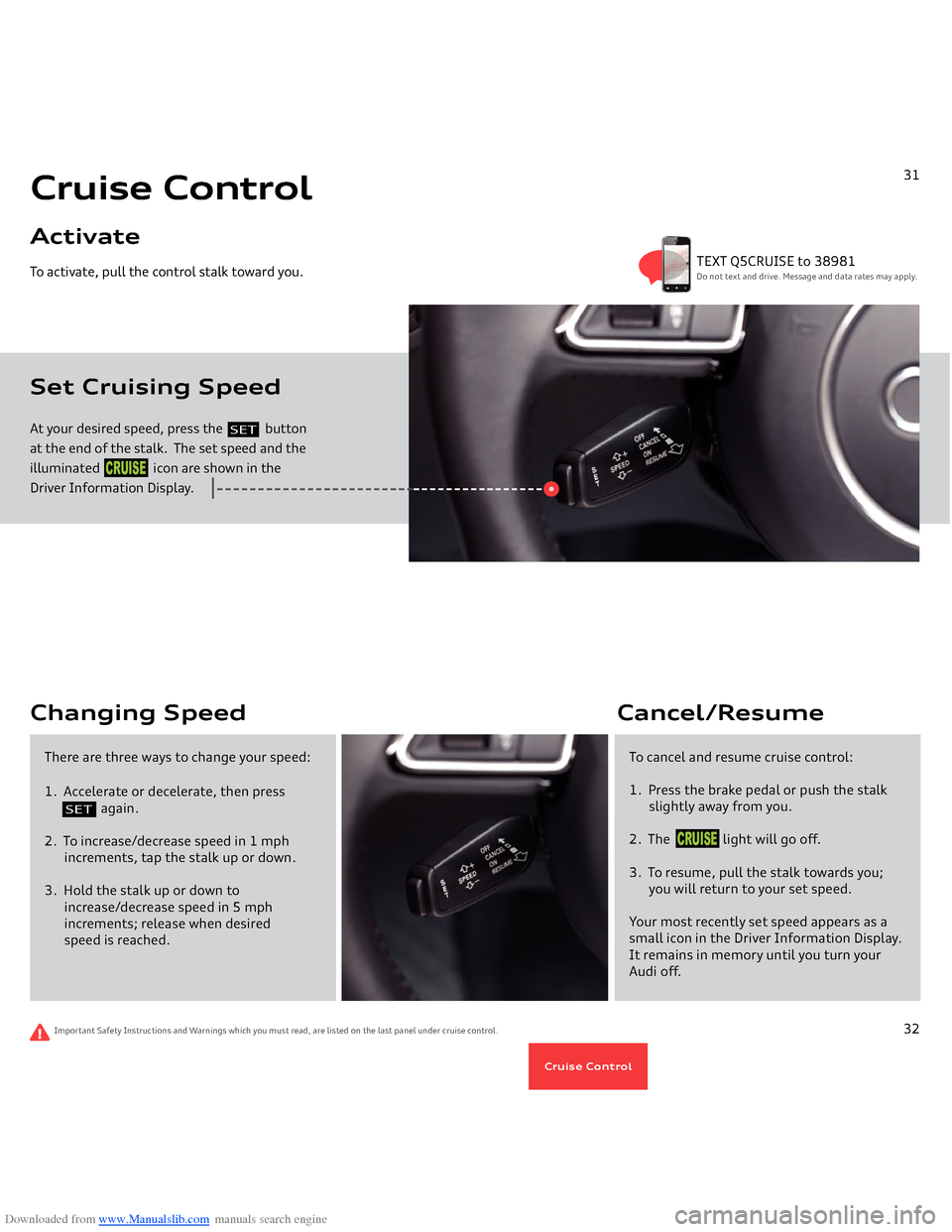
Downloaded from www.Manualslib.com manuals search engine At your desired speed, press the
button
at the end of the stalk. The set speed and the illuminated icon are shown in the Driver Information Display.To activate, pull the control stalk toward you.Set Cruising Speed Cruise ControlActivate
31
SET
CRUISE
TEXT Q5CRUISE to 38981Do not text and drive. Message and data rates may apply.
Important Safety Instructions and Warnings which you must read, are listed on the last panel under cruise control.
Changing Speed
To cancel and resume cruise control:1. Press the brake pedal or push the stalk
slightly away from you.2. The light will go off.3. To resume, pull the stalk towards you;
you will return to your set speed.Your most recently set speed appears as a small icon in the Driver Information Display. It remains in memory until you turn your Audi off.Cancel/Resume
There are three ways to change your speed:1. Accelerate or decelerate, then press
again.
2. To increase/decrease speed in 1 mph
increments, tap the stalk up or down.3. Hold the stalk up or down to
increase/decrease speed in 5 mph
increments; release when desired
speed is reached.
32
SET
CRUISE
Cruise Control
Page 20 of 29
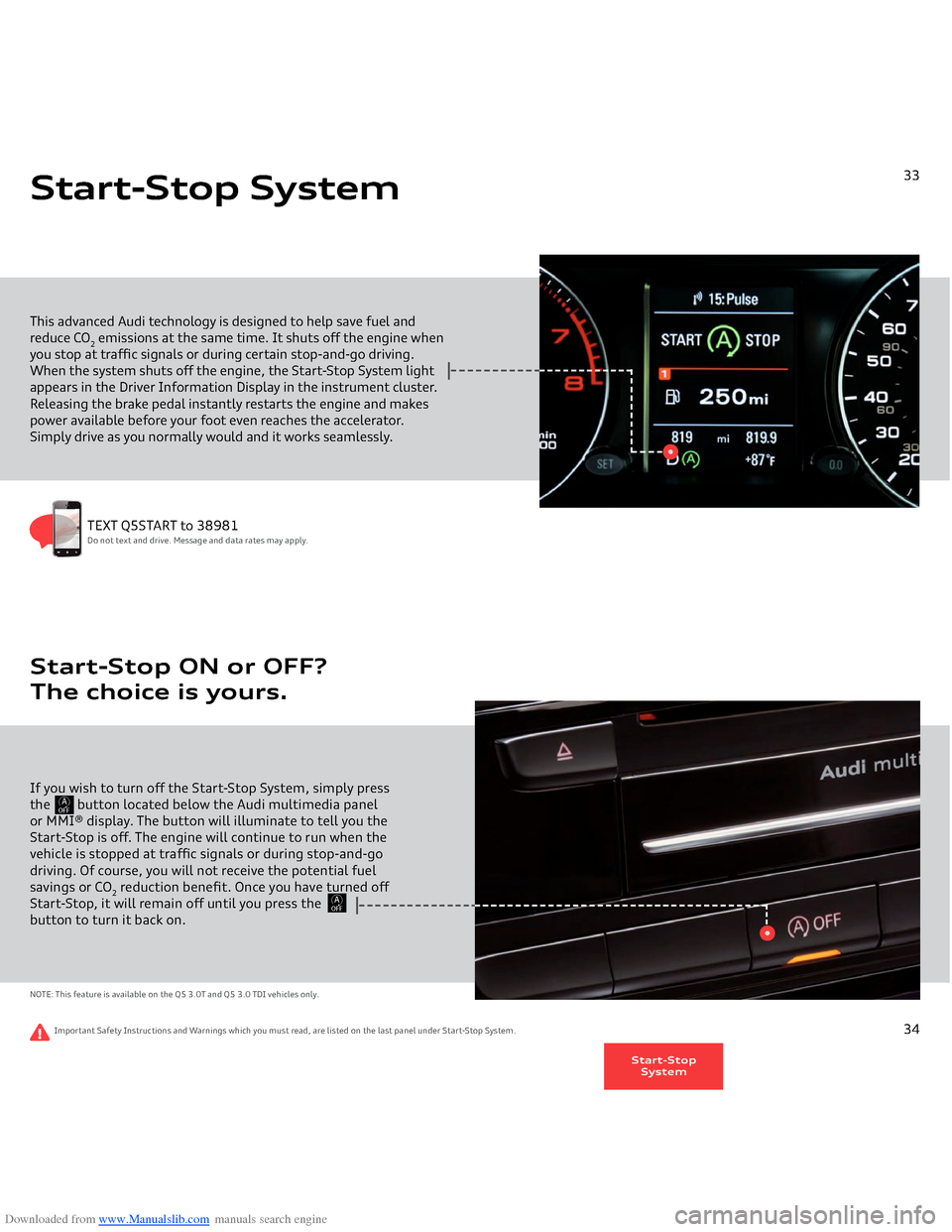
Downloaded from www.Manualslib.com manuals search engine This advanced Audi technology is designed to help save fuel and reduce CO
2 emissions at the same time. It shuts off the engine when
you stop at traffic signals or during certain stop-and-go driving. When the system shuts off the engine, the Start-Stop System light appears in the Driver Information Display in the instrument cluster. Releasing the brake pedal instantly restarts the engine and makes power available before your foot even reaches the accelerator. Simply drive as you normally would and it works seamlessly.Start-Stop System
33
TEXT Q5START to 38981Do not text and drive. Message and data rates may apply.
Important Safety Instructions and Warnings which you must read, are listed on the last panel under Start-Stop System.
If you wish to turn off the Start-Stop System, simply press the
button located below the Audi multimedia panel
or MMI® display. The button will illuminate to tell you the Start-Stop is off. The engine will continue to run when the vehicle is stopped at traffic signals or during stop-and-go driving. Of course, you will not receive the potential fuel savings or CO
2 reduction benefit. Once you have turned off
Start-Stop, it will remain off until you press the button to turn it back on.NOTE: This feature is available on the Q5 3.0T and Q5 3.0 TDI vehicles only.Start-Stop ON or OFF? The choice is yours.
34
AOFF
AOFF
Start-StopSystem
Page 21 of 29
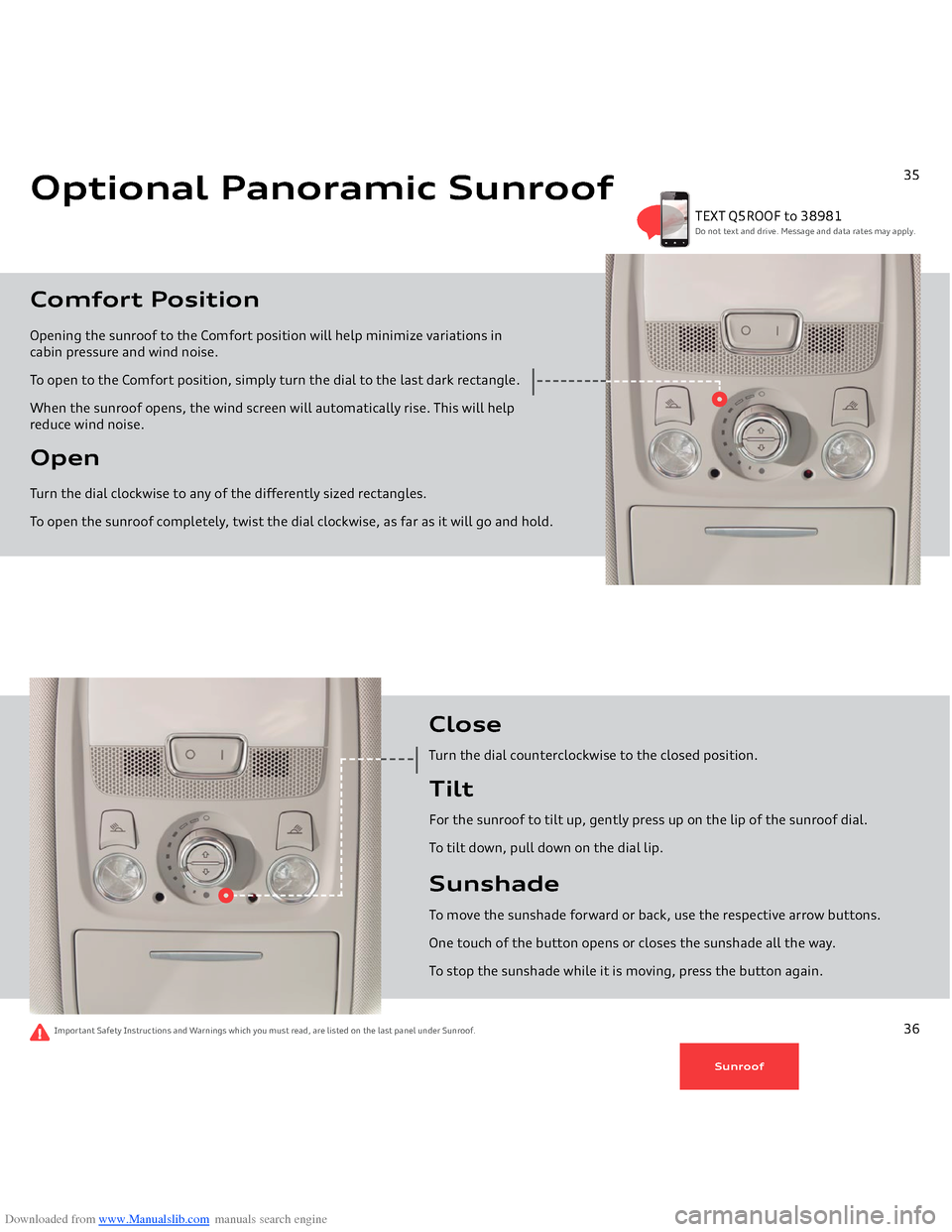
Downloaded from www.Manualslib.com manuals search engine Optional Panoramic SunroofOpen Turn the dial clockwise to any of the differently sized rectangles. To open the sunroof completely, twist the dial clockwise, as far as it will go and hold.Comfort PositionOpening the sunroof to the Comfort position will help minimize variations in cabin pressure and wind noise. To open to the Comfort position, simply turn the dial to the last dark rectangle. Wh
en the sunroof opens, the wind screen will automatically rise. This will help
reduce wind noise.
TEXT Q5ROOF to 38981Do not text and drive. Message and data rates may apply.
35
CloseTurn the dial counterclockwise to the closed position.TiltFor the sunroof to tilt up, gently press up on the lip of the sunroof
dial.
To tilt down, pull down on the dial lip.SunshadeTo move the sunshade forward or back, use the respective arrow buttons. One
touch of the button opens or closes the sunshade all the way.
To s
top the sunshade while it is moving, press the button again.
Important Safety Instructions and Warnings which you must read, are listed on the last panel under Sunroof.
36
Sunroof
Page 23 of 29
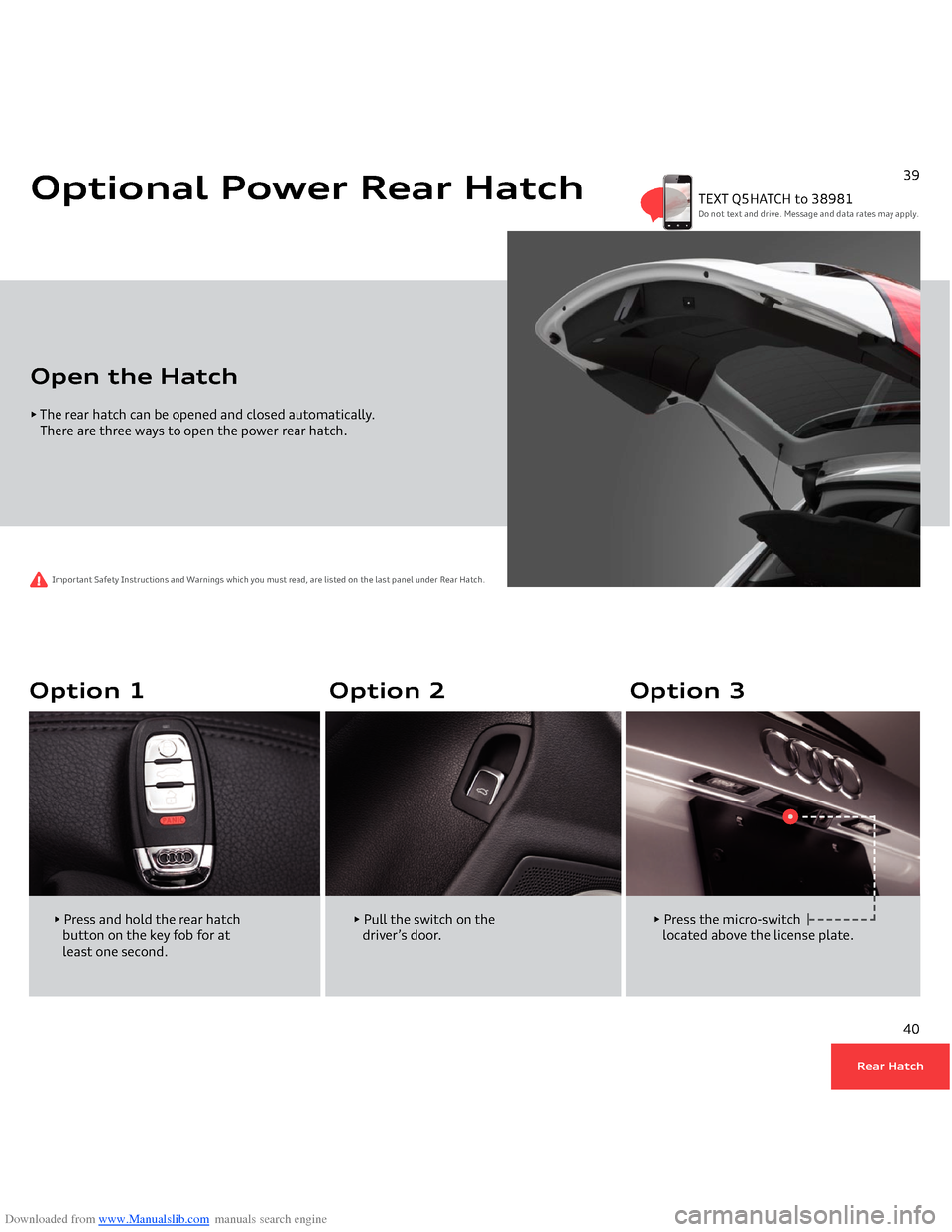
Downloaded from www.Manualslib.com manuals search engine • The rear hatch can be opened and closed automatically. There are three ways to open the power rear hatch.Open the Hatch
Important Safety Instructions and Warnings which you must read, are listed on the last panel under Rear Hatch.
NOTE: Photo may not represent actual vehicle.
TEXT Q5HATCH to 38981Do not text and drive. Message and data rates may apply.
39
Optional Power Rear Hatch
• Press and hold the rear hatch
button on the key fob for at
least one second.
• Pull the switch on the
driver’s door.
• Press the micro-switch
located above the license plate.
Option 1
Option 2
Option 3
Rear Hatch
40
Page 25 of 29
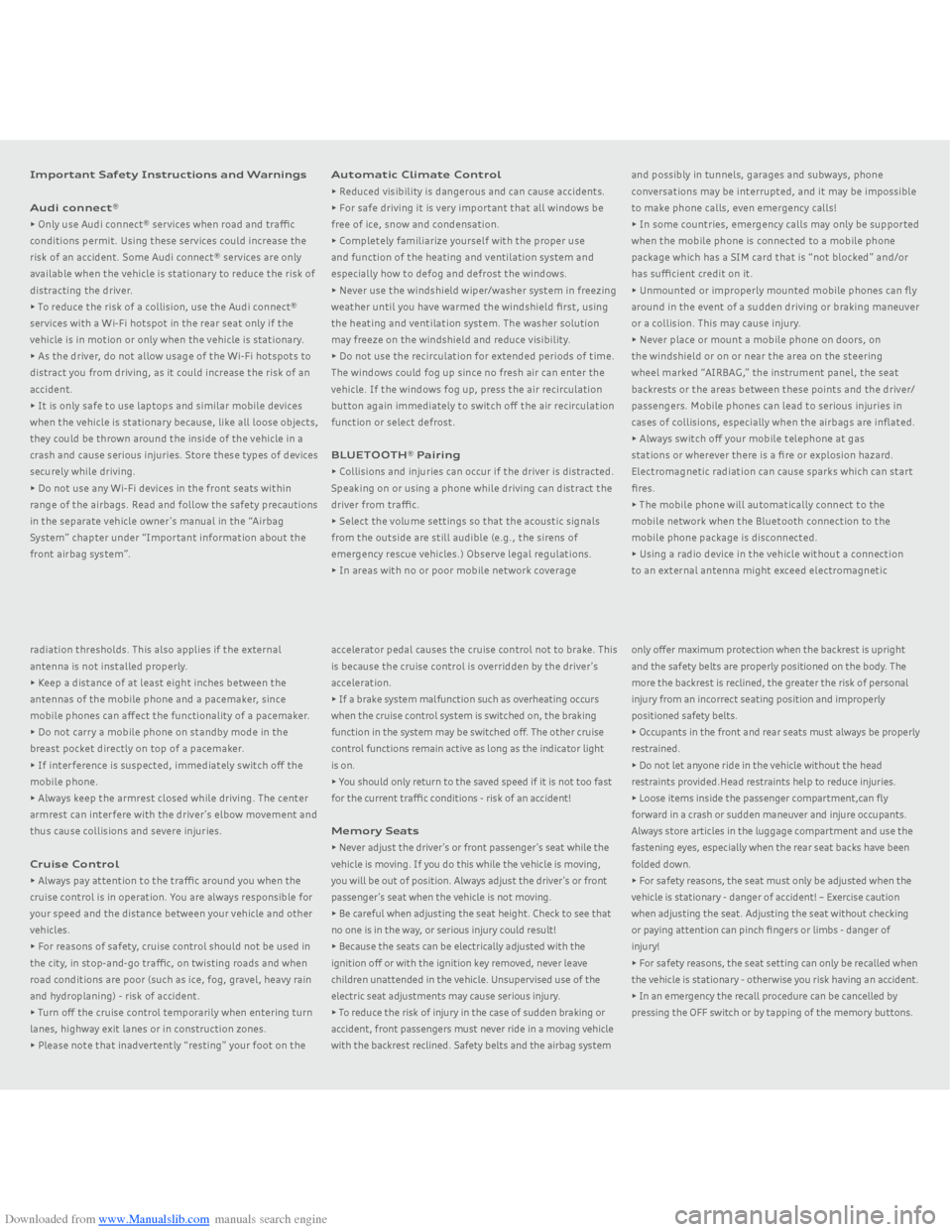
Downloaded from www.Manualslib.com manuals search engine Important Safety Instructions and WarningsAudi connect
®
• Only use Audi connect® services when road and traffic conditions permit. Using these services could increase the risk of an accident. Some Audi connect® services are only available when the vehicle is stationary to reduce the risk of distracting the driver.• To reduce the risk of a collision, use the Audi connect® services with a Wi-Fi hotspot in the rear seat only if the vehicle is in motion or only when the vehicle is stationary.• As the driver, do not allow usage of the Wi-Fi hotspots to distract you from driving, as it could increase the risk of an accident.• It is only safe to use laptops and similar mobile devices when the vehicle is stationary because, like all loose objects, they could be thrown around the inside of the vehicle in a crash and cause serious injuries. Store these types of devices securely while driving.• Do not use any Wi-Fi devices in the front seats within range of the airbags. Read and follow the safety precautions in the separate vehicle owner’s manual in the “Airbag System” chapter under “Important information about the front airbag system”.
Automatic Climate Control• Reduced visibility is dangerous and can cause accidents.• For safe driving it is very important that all windows be free of ice, snow and condensation.• Completely familiarize yourself with the proper use and function of the heating and ventilation system and especially how to defog and defrost the windows.• Never use the windshield wiper/washer system in freezing weather until you have warmed the windshield first, using the heating and ventilation system. The washer solution may freeze on the windshield and reduce visibility.• Do not use the recirculation for extended periods of time. The windows could fog up since no fresh air can enter the vehicle. If the windows fog up, press the air recirculation button again immediately to switch off the air recirculation function or select defrost.BLUETOOTH
® Pairing
• Collisions and injuries can occur if the driver is distracted. Speaking on or using a phone while driving can distract the driver from traffic.• Select the volume settings so that the acoustic signals from the outside are still audible (e.g., the sirens of emergency rescue vehicles.) Observe legal regulations.• In areas with no or poor mobile network coverage
and possibly in tunnels, garages and subways, phone conversations may be interrupted, and it may be impossible to make phone calls, even emergency calls!• In some countries, emergency calls may only be supported when the mobile phone is connected to a mobile phone package which has a SIM card that is “not blocked” and/or has sufficient credit on it.• Unmounted or improperly mounted mobile phones can fly around in the event of a sudden driving or braking maneuver or a collision. This may cause injury.• Never place or mount a mobile phone on doors, on the windshield or on or near the area on the steering wheel marked “AIRBAG,” the instrument panel, the seat backrests or the areas between these points and the driver/passengers. Mobile phones can lead to serious injuries in cases of collisions, especially when the airbags are inflated.• Always switch off your mobile telephone at gas stations or wherever there is a fire or explosion hazard. Electromagnetic radiation can cause sparks which can start fires.• The mobile phone will automatically connect to the mobile network when the Bluetooth connection to the mobile phone package is disconnected.• Using a radio device in the vehicle without a connection to an external antenna might exceed electromagnetic
radiation thresholds. This also applies if the external antenna is not installed properly.• Keep a distance of at least eight inches between the antennas of the mobile phone and a pacemaker, since mobile phones can affect the functionality of a pacemaker.• Do not carry a mobile phone on standby mode in the breast pocket directly on top of a pacemaker.• If interference is suspected, immediately switch off the mobile phone.• Always keep the armrest closed while driving. The center armrest can interfere with the driver’s elbow movement and thus cause collisions and severe injuries.Cruise Control
• Always pay attention to the traffic around you when the cruise control is in operation. You are always responsible for your speed and the distance between your vehicle and other vehicles.• For reasons of safety, cruise control should not be used in the city, in stop-and-go traffic, on twisting roads and when road conditions are poor (such as ice, fog, gravel, heavy rain and hydroplaning) - risk of accident.• Turn off the cruise control temporarily when entering turn lanes, highway exit lanes or in construction zones.• Please note that inadvertently “resting” your foot on the
accelerator pedal causes the cruise control not to brake. This is because the cruise control is overridden by the driver’s acceleration.• If a brake system malfunction such as overheating occurs when the cruise control system is switched on, the braking function in the system may be switched off. The other cruise control functions remain active as long as the indicator light is on.• You should only return to the saved speed if it is not too fast for the current traffic conditions - risk of an accident!Memory Seats• Never adjust the driver’s or front passenger’s seat while the vehicle is moving. If you do this while the vehicle is moving, you will be out of position. Always adjust the driver’s or front passenger’s seat when the vehicle is not moving.• Be careful when adjusting the seat height. Check to see that no one is in the way, or serious injury could result!• Because the seats can be electrically adjusted with the ignition off or with the ignition key removed, never leave children unattended in the vehicle. Unsupervised use of the electric seat adjustments may cause serious injury.• To reduce the risk of injury in the case of sudden braking or accident, front passengers must never ride in a moving vehicle with the backrest reclined. Safety belts and the airbag system
only offer maximum protection when the backrest is upright and the safety belts are properly positioned on the body. The more the backrest is reclined, the greater the risk of personal injury from an incorrect seating position and improperly positioned safety belts.• Occupants in the front and rear seats must always be properly restrained.• Do not let anyone ride in the vehicle without the head restraints provided.Head restraints help to reduce injuries.• Loose items inside the passenger compartment,can fly forward in a crash or sudden maneuver and injure occupants.Always store articles in the luggage compartment and use the fastening eyes, especially when the rear seat backs have been folded down.• For safety reasons, the seat must only be adjusted when the vehicle is stationary - danger of accident! – Exercise caution when adjusting the seat. Adjusting the seat without checking or paying attention can pinch fingers or limbs - danger of injury!• For safety reasons, the seat setting can only be recalled when the vehicle is stationary - otherwise you risk having an accident.• In an emergency the recall procedure can be cancelled by pressing the OFF switch or by tapping of the memory buttons.